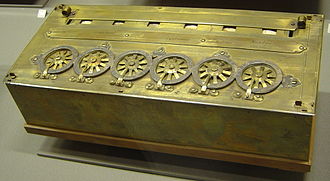Pascal's calculator
A Pascaline, signed by Pascal in 1652
Pascal's calculator was especially successful in the design of its carry mechanism, which adds 1 to 9 on one dial, and when it changes from 9 to 0, carries 1 to the next dial. His innovation made each digit independent of the state of the others, which enabled multiple carries to rapidly cascade from one digit to another regardless of the machine's capacity. Pascal was also the first to shrink and adapt for his purpose a lantern gear, used in turret clocks and water wheels, which could resist the strength of any operator input with very little added friction.
Nine Pascal calculators have been made,[2] including the first surviving mechanical calculator from the 17th century. Most of them are on display in European museum

No comments:
Post a Comment